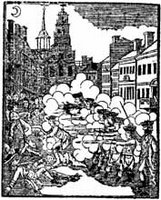The Massacre, Black Lives, and Boys
 Before departing this Massacre season, I want to call attention to Farah Peterson’s thought-provoking article in The American Scholar titled “Black Lives and the Boston Massacre.”
Before departing this Massacre season, I want to call attention to Farah Peterson’s thought-provoking article in The American Scholar titled “Black Lives and the Boston Massacre.”
Peterson, a law professor and legal historian at the University of Virginia School of Law, writes:
The trial cemented [John] Adams’s reputation as the archetypal lawyer-as-hero, a man willing to be hated in order to give individuals the chance to have their cause fairly heard. And it confirmed for Revolutionary British North Americans that theirs was a cause rooted in legal ideals. We have remembered the trial this way ever since: as a triumph of principle over self-interest or impetuous emotionalism.Peterson underscores how Adams’s trial argument made the most of Crispus Attucks being a tall, muscular man of color, just as apologists for some recent dubious law-enforcement shootings have insisted that young black men or children looked dangerous.
But an honest look at the transcript complicates the story by showing how racial prejudice contributed to the outcome. A critical part of Adams’s strategy was to convince the jury that his clients had only killed a black man and his cronies and that they didn’t deserve to hang for it.
That’s an compelling parallel to think about, and not necessarily new. Twenty years ago, the Massacre reenactment took place a month after New York police officers killed Amadou Diallo, and some people in the crowd called out the similarities.
Ironically, Peterson undercuts the argument with the way she presents the start of the confrontation on King Street:
This is how the massacre began, with a group of “boys”—that is, teenagers—surrounding a young soldier named Hugh White, who was standing stiffly in his red coat on sentry duty at the Custom House. They started shouting at him, calling him a “son of a bitch” and a “lobster” and screaming to each other (hilariously), “Who buys lobster?” They made a game of pitching snowballs and debris at him and joked about picking up the sentry box and lobbing it into Boston Harbor.That description has (white) teenagers picking on Pvt. White for no reason. But the sentry was the first to use violence, clubbing an apprentice named Edward Garrick for speaking disrespectfully of an army captain. The article refers to “a rumor that a soldier had hurt a young boy,” immediately suggesting that rowdies might have concocted that story to rile up other Bostonians. In fact, there’s a lot of testimony about the interaction between the sentry and the apprentice.
Peterson quotes Adams reminding the soldiers’ jury about “a motley rabble of saucy boys, negroes and molattoes, Irish teagues and outlandish jack tars.” Genteel society worried about all those classes of people, seeing them as on the boundaries of society and prone to impetuous violence.
Peterson rightly notes how Adams’s argument as a defense attorney and a Whig depended on casting such a mob as unrepresentative of Boston. That was a common stance for Boston politicians; the year before, Loyalist printer John Mein had complained about their “usual sayings” that any violence “was done by Boys & Negroes, or by Nobody.” The blame never fell just on blacks—those men were always grouped with boys and/or sailors.
Thus, while rightly noting how Adams played on the prejudice against men of color like Attucks, Peterson’s recounting of the Massacre trips into replicating the similar prejudice against teenagers.

No comments:
Post a Comment